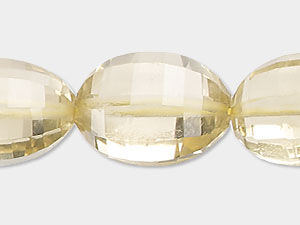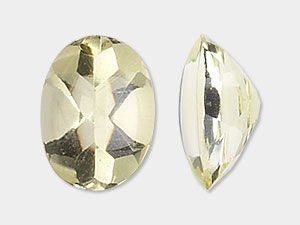Quartz, Lemon Meaning and Properties
Lemon Quartz History
Lemon quartz is a newer gemstone, first created in the 20th century and not sold commercially until the 1980s. Also known as Oro (or Ouro) Verde Quartz, meaning “green gold,” lemon quartz is created by heating amethyst or yellow or clear quartz and iron together through a process of gamma-ray irradiation followed by a heat treatment for stabilization. This process gives lemon quartz its brilliant yellow color. The glorious beauty of lemon quartz is truly dazzling, particularly when light catches the facets and it truly comes to life.
What are the Metaphysical Properties of Lemon Quartz?
Quartz is said to help structure, focus and amplify thoughts and information. It is also thought to transmit energy. Because the color yellow is associated with clarity, communication and happiness, lemon quartz meaning includes balancing and strengthening these traits.
Used in meditation, lemon quartz is believed to filter out distractions, aid concentration and open memory. Lemon quartz meaning is also associated with reducing anxiety, bringing in money and assistance in times of need, and decreasing negativity. Advocates recommend it be used with the third eye, solar plexus and crown chakras.
For those who use crystals for healing, lemon quartz is thought to ease food and nicotine cravings, help with diabetes and encourage healthy recovery after illness or surgery.
What is Lemon Quartz Made From?
The amethyst and clear and smoky quartz mined to create lemon quartz primarily come from Brazil, although deposits of heatable amethyst have also been found in Arizona. Although it is rare, lemon quartz has been found to display cat’s eye chatoyancy and asterism.
Quartz is the best-known piezoelectric gem—that is, it can carry an electrical charge when exposed to an applied voltage, in response to pressure or in response to mechanical stressors. Quartz is also a pyroelectric gem—able to generate an electric charge through rapid states of temperature change. These are the scientific qualities behind reliable and accurate quartz movements in watches (regardless of weather). The same properties mean it is ideal for use in microphones, speakers, filters—even sonar!
- Mineral Information: Silicon dioxide
- Chemical Composition: SiO2
- Color: Bright yellow to pale green; translucent
- Hardness: 7 (Mohs)
- Specific Gravity: 2.65
- Refractive Index: 1.54 - 1.55
- Cause of Color: Heat and iron
How Do You Clean Lemon Quartz?
Lemon quartz is moderately hard, so it can be cleaned with an ultrasonic cleaner. Avoid heat with most forms of colorful quartzes to prevent hue shift. Store lemon quartz out of direct sunlight to preserve its color.
Lemon Quartz FAQ
Q: Is lemon quartz a natural stone or is it enhanced?
A: Lemon quartz does not occur naturally, although the quartz from which it is made is a natural gemstone. Lemon quartz is created through a process of applying gamma-ray radiation—followed by heat—to either clear or smoky quartz or amethyst, which is itself a variety of quartz.
Q: Does lemon quartz have typical inclusions or visual characteristics?
A: Lemon quartz is known for its clarity and lack of visible inclusions. The glass-like luster is one of the reasons for lemon quartz’s popularity.
Q: Can I wear a bracelet every day that is made with lemon quartz beads?
A: With a Mohs hardness of 7, lemon quartz is hardy enough to wear daily. Despite its durability, lemon quartz is not indestructible. Avoid excessive abrasion and heavy impacts to keep it in top condition.
Q: Why are some lemon quartz beads lighter in color and some are darker?
A: The precise hue of lemon quartz is influenced by the type and concentration of trace minerals present, along with the specifics of the irradiation process used to create its color.
Q: How is lemon quartz different from other yellow quartz varieties?
A: There are several varieties of yellow quartz, in addition to lemon quartz:
Citrine is a form of quartz that naturally occurs in a pale, golden honey color, as opposed to the bright and even greenish yellow of lemon quartz, although most gemstones sold as “citrine” are heat-treated amethyst or smoky quartz, with iron inclusions providing a rich, sunny hue that trends toward orange tones. Like lemon quartz, citrine is transparent .
Lemon smoky quartz is created using the same methods as lemon quartz, but instead of using amethyst, clear quartz or yellow quartz for the original stone, smoky quartz is used. This produces a more muted, neutral yellow with undertones of green, brown and gray and less transparency than lemon quartz.
Yellow Iron Quartz : With inclusions of iron and sometimes other minerals, yellow iron quartz will have swirls of color instead of being a solid yellow or white. It will have a milky, semi-translucent opacity.
Yellow or golden “jade”: Varieties of yellow quartz—natural or dyed—may be sold as yellow “jade” or golden “jade” because of a milky translucency, waxy sheen and similarity to natural jade.
In addition, distributors may give certain hues of natural, dyed or heat-treated quartz special names for the retail market, such as golden quartz , golden cream quartz or chardonnay quartz.
Designing with Lemon Quartz
Many designers like to complement lemon quartz with amethyst or contrast it with black onyx. A favorite among designer artists is to alternate lemon quartz with hand-carved oval carnelian . The deep, reddish orange of carnelian balances the translucent, sparkly yellow of the lemon quartz, offering unique and inviting combinations. Accent with sterling spacers or Hill Tribes beads of like or varying sizes. This stone is ideal for dressing up everyday wear because of its durability and neutral tone.
Why limit this gem to jewelry?
Lemon quartz, because of its natural sparkle and shine, brightens up lampshades and window treatments of all styles. String lemon quartz with faceted Czech fire-polished glass beads —or lemon quartzes of your choice—and dangle teardrop crystals for a dramatic, shimmering effect. Pin the wire strands 2 to 3 inches apart along the bottom of the shade or window treatment. One of the "fringe" benefits of pinning the wire is that it provides a secure hold that can still be removed for cleaning or interchanging with other lemon quartz creations for endless decorating possibilities.
Shop for Lemon Quartz
**Please note that all metaphysical or healing properties listed are collected from various sources. This information is offered as a service and not meant to treat medical conditions. Fire Mountain Gems and Beads® does not guarantee the validity of any of these statements.
How did you like this resource? Your feedback helps us provide resources that matter to you most.
Copyright Permissions
All works of authorship (articles, videos, tutorials and other creative works) are from the Fire Mountain Gems and Beads® Collection, and permission to copy is granted for non-commercial educational purposes only. All other reproduction requires written permission. For more information, please email copyrightpermission@firemtn.com.


